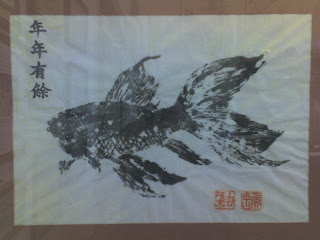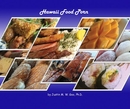Vietnam is, among other things, extremely French. With the French, having occupied thier country for such a long time, it is no wonder that they've very heavily influenced the Vietnamese culture. But it isn't one of those instances where a culture influences another and they've blended so much that it's difficult to see where one begins and the other ends. It's more like a chocolate/vanilla swirl. The French aspects remain distinctly French, and the native Vietnamese aspects distinctly Vietnamese. They co-exist side by side in everything from the languge to the food. They are mixed together yes, but you can still distinctly discern the chocolate from the vanilla.
Hawaii gets its European influence from the British and the Portuguese. Unlike places further south, like Tahiti, the French didn't really have much of a foothold in our history. But as the Vietnamese came over, they brought with them their delicate balance of European and Southeast Asian flavors, and got us totally hooked. This is perhaps most evident in our favorite Vietnamese sandwiches, known as Banh Mi.
When it comes to Vietnamese sandwiches in Hawaii, Ba-Le pretty much has the monopoly. They're all over town, and probably the first place that comes to mind when people think of Banh Mi. However, as great as Ba-Le (which BTW means Paris in Vietnamese) can be, the problem with a chain that large is one of consistency. I have walked into Ba-Le shops where the bread is so stale, I have to use my back molars to crush through the crust. Then I couldn't bite off a mouthful, but would have to tear it off. Even after much difficult chewing, it's difficult to swallow because it's so dry. This is not to say that all Ba-Le are like that, I have had some really good sandwiches at Ba-Le, but unfortunately you have to know which ones are the good ones and which aren't. Alternatively, you can find a small mom and pop shop that you know is consistently good. My favorite place for Banh Mi, would have to be Saigon's on Waialae (right next door to Toys-n-Joys).
Ham & Steamed Pork Sandwich at Saigon's
Ever heard the saying that a sandwich is all about the bread? Good bread makes or breaks a sandwich. It's more important than the filling. Good bread will make up for mediocre filling, but good filling will not make up for mediocre bread. It's sort of a baker's mantra. Well, to me the best bread, is found at Saigon's. Ask them to double toast it, and invariably, the crust is flaky and crunchy, but not too hard. The inside is soft and has a nice chewiness, a sponginess to it. The bread itself is completely French. The addition of a nice, rich shmear of pate or mayo, even more French. But the other ingredients, pickled carrot, daikon, and cucumber with a little Chinese parsley, is completely Vietnamese. My favorite sandwich includes another dichotomy of ham (totally French), and Vietnamese sausage or gio (totally Vietnamese). The gio is something like fish cake or possibly bologna in texture. But it's flavor is a wonderful pork and fish sauce mixture, that is sublimely savory. Just like chocolate/vanilla swirl, the Eastern flavors and Western flavors are still very distinct, but taste perfectly in harmony with one another.
Lemongrass Chicken Sandwich at Saigon's
Want to go with a spicier, herbier alternative? The lemongrass chicken sandwich has the same heady lemongrass flavor as Bun Bo Hue. The spiciness is just enough to give it a kick. But it is that wonderful aroma that the lemongrass gives it, which is so distinctly Southeast Asian. The sauce from the chicken also makes this sandwich moister, kind of like dipping in au jus.
Beef Stew at Saigon's
When it comes to dinner time though, there is a better way to enjoy Saigon's fantastic bread. That is having the bread accompany their wonderful beef stew. Now this beef stew is not like our local beef stew. For one thing, it is a very thin stew, almost a soup. For another, the ingredients are classically French, some carrot and onions. But the beef is unbelievably tender, and combined with the melt-in-your-mouth beef tendon, this is almost the equivalent of the ngau lam mein over at Mini Garden. Finally the stew has all of those incredibly aromatic herbs that the Vietnamese use. But what makes this so different, is that unlike how we eat our thick, tomatoey beef stew over rice, this beef stew is meant to have the bread dipped in it, the French way. So in one mouthful, you have the fantastic texture of crispy, crunchy crust and soft cushiony bread, mixed with that incredibly complex symphony of herbs and beefiness so characteristic of Vietnamese cuisine. The combination of flavors and textures is just mind numbing. It's almost a sensory overload.
So now that we've got the best, flaky, crispy, crumbly bread, we need that heady French coffee to accompany it. The funny part is that most Vietnamese restaurants in town these days, get their French coffee by way of yet another French town, New Orleans. Specifically, most Vietnamese restaurants here serve coffee from the famed Cafe du Monde, in the French Quarter. But the way they serve it is distinctly Vietnamese. With that personal coffee press, where you get to watch the slow thick drops of coffee fall one by one into the waiting pool of condensed milk below. It's not a morning cup of joe you gulp down. This coffee is meant to be anticipated, as you watch it brew drip by drip, smelling the aroma the whole time. And when it's finally done, and you swirl the dark brew with the creamy condensed milk together and pour it over ice, there is nothing better to accompany the great French bread.
Just like the little cafes you'll find in Paris, Saigon, or New Orleans, Saigon's in Kaimuki is just that wonderful quaint little streetside family owned shop. It is where East and West swirl in perfect harmony, one drop and one bite at a time.

































